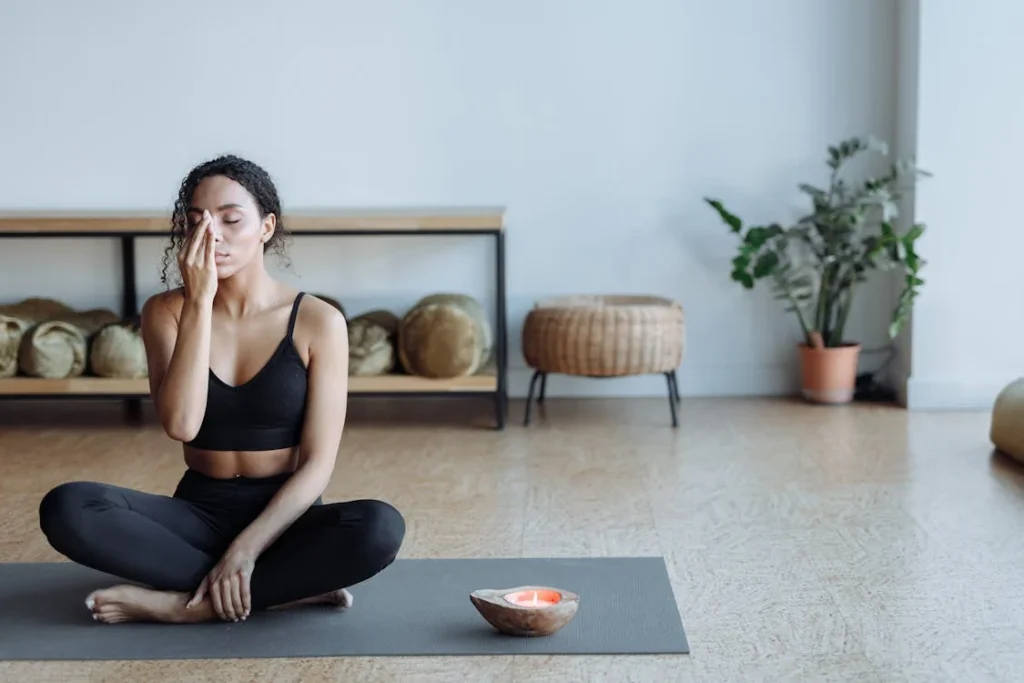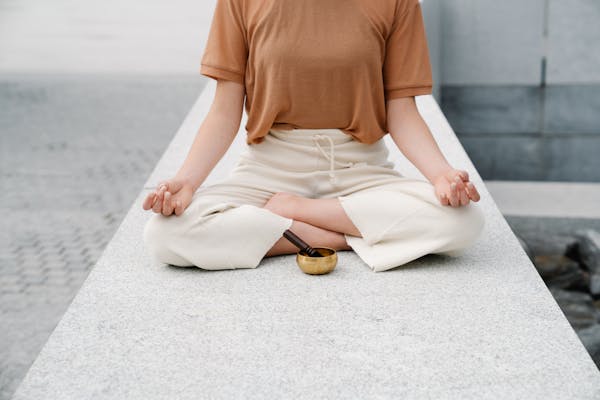Table of Contents
Introduction
Pranayama For BP High blood pressure, also known as hypertension, is one of the most common health conditions affecting millions of people all over the world.
Commonly known as the “silent killer,” a person might face serious complications such as heart disease, stroke, or kidney damage, without displaying apparent symptoms at first. Medication, lifestyle modification, and regular exercise are common therapies to control high blood pressure.
More and more people are now using natural therapy systems, such as yoga and pranayama (breath control), to effectively control their BP.
In this blog, we’re going to discuss the benefits of pranayama in BP management, and we’ll see how specific breathing techniques can help reduce one’s BP. Understanding how pranayama affects the cardiovascular system can be applied in real life, with opportunities to lead to benefits in well-being.
Understanding High Blood Pressure (Hypertension)
Before practicing pranayama, you must first know what high blood pressure is and how it works in the human body. Blood pressure can simply be defined as the force exerted by the blood upon the walls of your arteries as your heart pumps blood.
BP reading actually consists of two numbers: systolic, or top number which is a measure of the pressure in your arteries when your heart is beating, and diastolic, or bottom number- the pressure in your arteries when your heart is resting between beats.
A normal BP is generally around 120/80 mm Hg. One whose blood pressure always goes above 130/80 mm Hg is considered to have high BP. Over time, it may damage the blood vessels, add strain to the heart and so negatively affect vital organs.
Causes of High Blood Pressure
Poor Diet: Many who take too much salt or processed foods along with unhealthy fats contribute to elevated blood pressure.
Lack of Physical Activity: A sedentary lifestyle weakens the heart; thereby, it cannot pump blood properly.
Stress and Anxiety: Prolonged psychological stress and anxiety may cause the body to produce stress hormones called cortisol, which can elevate blood pressure.
Obesity: An overweight condition increases the chances of developing high blood pressure.
Genetics: If there is a family history of hypertension, then the risk of inheriting the disease would increase.
Tobacco and Alcohol: Tobacco smoking and alcoholism may be a cause for long term rise of BP
Given all this, the treatment of high blood pressure is essentially an integral part of long term health management. Pranayama is a non-medical cure that can be used along with medical treatment for this condition.
How Pranayama Helps Manage High Blood Pressure
Pranayama or the breathing control is that practice which effectively helps control the high blood pressure. The main exercise allows the soothing of the nervous system, enhances oxygenation, and removes stress. Cardiovascular system improvement, reduction of cortisol, relaxation of the blood vessels, and improving blood flow are the central ways in which the practice could reduce the BP levels.
Key Benefits of Pranayama to Manage BP
Reduces Stress and Anxiety: One of the main causes of high BP is stress. Practicing Nadi Shodhana (alternate nostril breathing) and Bhramari (bee breath) would calm the nervous system, consequently lessening the production of stress hormones that cause blood pressure elevation.
Improves Oxygen Supply: Controlled breathing increases the supply of oxygen in the blood; thereby improving circulation and makes the heart pump with more efficiency. Techniques like Ujjayi Pranayama or victorious breath help in deep breathing and more oxygen is taken in by the blood while reducing the pressure in the cardiovascular system.
Controls Nervous System: Parasympathetic the parasympathetic nervous system, commonly known as the “rest and digest” system. This would decrease the “fight or flight” response that has spikes in BP. A relaxed body makes the heart work, and thus it calls for low blood pressure.
Enhances Blood Circulation: By practicing pranayama, the blood flow to vital organs, including the heart and brain, improves. This helps regulate BP levels, ensuring the heart does not have to work as hard to pump blood.
Low Heart Rate: The heart does not need much force to pump more blood because of a lower heart rate. Therefore, blood pressure declines. Some of the effective Pranayama practices in this category include Shavasana or corpse pose involving controlled respiration.
Scientific Evidence Supporting Pranayama for BP Control
Recent researches showed that pranayama has mitigating effects on hypertension. Published in the Indian Journal of Physiology and Pharmacology, there was the discovery on how regular practice of pranayama reduced the systolic and diastolic blood pressures of the individual participants.
In another case, pranayama has been used to reduce the readings of BP in hypertensive patients where the results were gotten without medical prescription.
Now that we have an overview of how pranayama functions on high blood pressure, we should discuss the different types of pranayama with the benefits for BP management.
Types of Pranayama for High Blood Pressure
1. Nadi Shodhana Pranayama (Alternate Nostril Breathing)
Nadi Shodhana, or alternate nostril breathing, is probably one of the most effective pranayama techniques to balance the nervous system and lower stress. It involves breathing in and then exhaling through alternate nostrils, thus stills the mind, reduces anxiety, and lowers BP.
How to Practice:
Sit comfortably with your spine erect.
Close your right nostril by bringing your thumb near to it and inhale slowly through your left nostril.
Now, close your left nostril using your ring finger and breathe out through the right side
Breathe in through the right side, close the right, and breathe out through the left
Do this cycle for 5 to 10 minutes
Benefits of Nadi Shodhana for BP:
This decreases the nerve stimulation and thus calms down the brain and body and gives relief from stress and anxiety
It makes the working of the left and right halves of the brain balanced
Boosts the heart and good blood flow because of the increase in oxygen
As it develops a relaxing effect, BP becomes normal and comes down naturally

2. Bhramari Pranayama (Bee Breath)
Bhramari Pranayama, or bee breath, while exhaling, produces a humming sound by stimulating the vagus nerve, which serves as an activator of parasympathetic nervous activity. This decreases the heart rate and blood pressure and is, therefore, a great exercise to do for people with hypertension.
Practice:
Sit comfortably with eyes closed.
Breathe in through nostrils deeply.
Inhalation through nose while exhaling make a soft buzzing sound like that of a bee.
Pay your focus on the vibration of the sound and maintain it for 5 to 10 minutes.
Benefits of Bhramari for BP:
This yamra quiets the mind, gets rid of mental turmoil, slows down heartbeats, and consequently lowers blood pressure.
Increases concentration and clear thinking of the mind and reduces the stress-induced spikes in BP.
It calms all the body parts, which ends up with deep relaxation.


3. Ujjayi Pranayama (Victorious Breath)
Ujjayi Pranayama, or breath of victory, is a technique in which you contract the back portion of the throat so you can breathe, and you hear an ocean-like sound while you either exhale or inhale. This helps induce control of the breath, which controls stress and creates optimal functioning in the cardiovascular system.
Practice Instructions:
Sit comfortably in a position that aligns your spine with an upright posture.
Breathe in slowly through your nose; contract the back portion of your throat slightly.
Exhale slowly through your nose; contract the back portion of your throat partly, using a muscular contraction, to produce the ocean wave sound.
Continue for 5-10 minutes, focusing on slow, deep breaths.
Benefits of Ujjayi Pranayama for BP:
Promotes deep breathing that further oxygenates and enhances blood circulation
Decreases anxiety and tension by soothing the nervous system
Manages controlled heart rate, naturally bringing down the blood pressure
Stimulates concentration and mental acuities and thus reduces stress effects on BP


4. Anulom Vilom Pranayama (Alternate Breathing Without Breath Retention)
Pranayama Anulom Vilom is more or less the same as Nadi Shodhana except there is no retention of breath. It is more suited for people with high BP as it maintains the flow of energy within the body without forcing too much pressure from the heart.
How to do it:
Sit upright and get relaxed.
Now, place your thumb on your right nostril so that you inhale air through your left nostril.
Close your left nostril by either pressing your ring finger against it or a finger ring. Now, exhale the air through your right nostril.
Breathe in through the nostril that is on your right, close it, and let out through the left.
Do it for 5 to 10 minutes.
Anulom Vilom for BP Benefits:
Equilibrium of energy flow, reduces stress and anxiety
Boosts oxygen supply to the blood in return improves the heart’s functionality.
Mental agitation reduces it, and calms your mind
Help reduce blood pressure naturally because of the regulation of breath


5. Shavasana (Corpse Pose with Breath Awareness)
Traditionally, Shavasana is a relaxation pose, but put together with slow, attentive breathing, it turns out to be an excellent technique for lowering BP. Through this technique, the body and the mind get perfectly relaxed, thereby reducing the workload on the cardiovascular system.
How to do it:
Lie on your back on a straight surface. Your legs are slightly parted and hands are loose by your sides.
Close your eyes and concentrate on your breath so that it becomes slow and steady.
Breathe slowly and calmly, observing how your chest is moving up and down.
Continue in this pose for 10-15 minutes, simply relaxing and observing breathing control.
Shavasana and BP:
It makes the body totally relaxed, thus reducing stress and tension.
It lowers heart rate and blood pressure.
Deep breathing that contributes to the increased oxygen supply to the blood.
It helps the body to achieve deep rest conditioning the entire cardiovascular system.


Conclusion
One of the holistic and natural ways to regulate high blood pressure is through pranayama. Since it works on causes, it will be able to regulate high blood pressure caused by stress, anxiety, and poor function in the cardiovascular system.
As these pranayama techniques become a habit, they help improve the cardiac state and mental clarity, in turn bringing down levels of high blood pressure.
Although BP pranayama is an effective practice, proper practice and consistency are required for safe participation. Its initial use is best done gradually, ideally under the guidance of a qualified teacher, and then gradually increased.
Combined with regular exercise, a healthy diet, and successful management of stress, pranayama can be an effective long-term part of managing high blood pressure to improve one’s well-being and heart health.

Pingback: The Advantage of Pranayama: Reveal the Hidden Secrets Behind Better Health and Wellness 2025 -